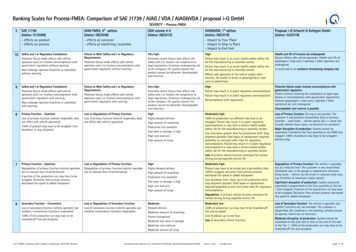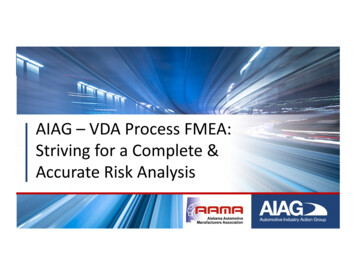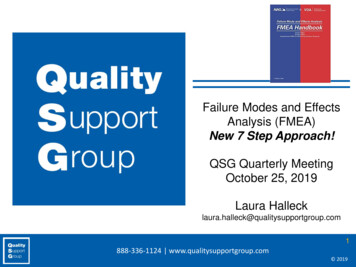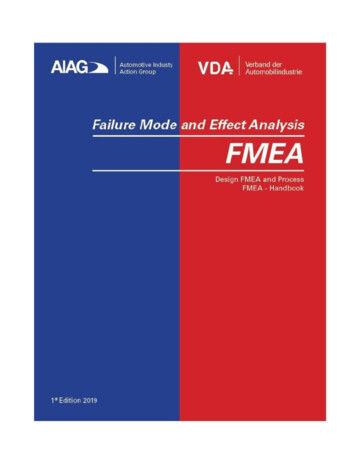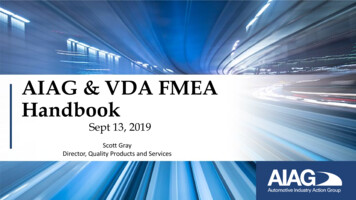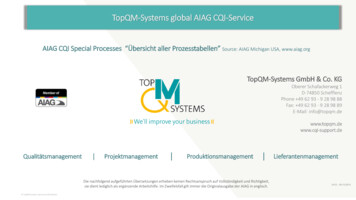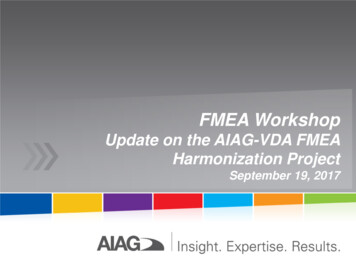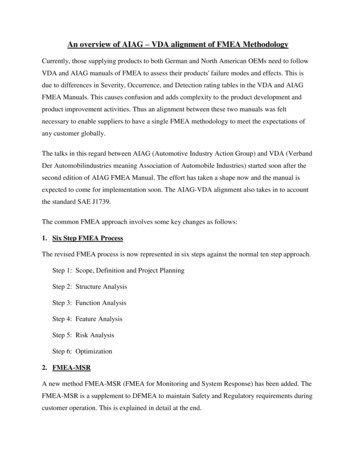
Transcription
An overview of AIAG – VDA alignment of FMEA MethodologyCurrently, those supplying products to both German and North American OEMs need to followVDA and AIAG manuals of FMEA to assess their products' failure modes and effects. This isdue to differences in Severity, Occurrence, and Detection rating tables in the VDA and AIAGFMEA Manuals. This causes confusion and adds complexity to the product development andproduct improvement activities. Thus an alignment between these two manuals was feltnecessary to enable suppliers to have a single FMEA methodology to meet the expectations ofany customer globally.The talks in this regard between AIAG (Automotive Industry Action Group) and VDA (VerbandDer Automobilindustries meaning Association of Automobile Industries) started soon after thesecond edition of AIAG FMEA Manual. The effort has taken a shape now and the manual isexpected to come for implementation soon. The AIAG-VDA alignment also takes in to accountthe standard SAE J1739.The common FMEA approach involves some key changes as follows:1. Six Step FMEA ProcessThe revised FMEA process is now represented in six steps against the normal ten step approach.Step 1: Scope, Definition and Project PlanningStep 2: Structure AnalysisStep 3: Function AnalysisStep 4: Feature AnalysisStep 5: Risk AnalysisStep 6: Optimization2. FMEA-MSRA new method FMEA-MSR (FMEA for Monitoring and System Response) has been added. TheFMEA-MSR is a supplement to DFMEA to maintain Safety and Regulatory requirements duringcustomer operation. This is explained in detail at the end.
FunctionPFMEAFunction or task of thework demand andcharacteristicFunction or outcome ofthe process step andcharacteristic description(quantitative value isoptional)Structure AnalysisFunction ofcomponentelement andrequirement orintended outputor characteristicFunction ofsystem elementand intendedperformanceoutputFunction ofsystem andrequirement orintended outputComponentElement(Item/Interface)Structure AnalysisProduct and /or processfunction that the processitem creates (product , inplant, ship to plant, enduser when knownProcess work element(Man, Machine, indirectMaterial, Environmentetc)Process StepSystem Element/InterfaceItemProcess step, station noand name of focuselementDFMEASystem (item)FunctionProcess item system, subsystem, part element orname of the process3. Two Types of Recommended Action“Recommended Action” has been changed to two columns: “Preventive Action: and “DetectionAction.” Evidence of these actions is also to be documented.4. Special CharacteristicsNo special characteristics column in DFMEAThe FMEA format undergoes revision as follows:The following tables explain how the present forms get changed in the new arrangement.5. FMEA FormatThe new FMEA format will have about 27 columns as explained below as against 17 columns atpresentFunction AnalysisFunction Analysis
Action PriorityDetectionOccurrenceSeverityCompletion dateAction taken with pointer to evidenceStatus – Open, Completed , DiscardedAction Priority(High, Medium orLow)Filter code(optional)Detection of FMOccurrence (O) ofFCDetection control(DC) of FC or FMCurrent preventioncontrol(PC) of FCRPNDetectionCurrent process controls DetectionCurrent process control PreventionOccurrenceClassificationSeverityFailure causes(FC)Failure ModeSeverity (S) ofFEFailureEffects (FE)Potentialcauses of failureClassificationSeverityPotential Effectsof failurePotential failuremodePresentTarget completion dateResponsible person’s nameDetection actionPrevention actionRevised RPNDetectionOccurrenceSeverityAction taken & effective dateResponsibility & targetcompletion dateRecommended actionFollowing are applicable for both DFMEA & PFMEANewFailure AnalysisRisk AnalysisOptimization
6. .RPN is replaced by Action Priority (AP)The Risk Priority Number (RPN) is replaced with Action Priority (AP) with High, Medium orLow categories to reduce the risk of failure. This is considered to be the most significantchange in the new FMEA. For many years, Quality professionals have been pointing out twomajor flaws in RPN methodology. It may be noted that the RPN is determined by multiplyingthe “Severity x Occurrence x Detection (or S x O x D)” rankings. Though this methodologyresults in 1000 different combinations, the number of different RPNs are only 120. Forexample, see below how RPN value of 360 can have 15 different SOD combinations. The otherproblem is that even these 120 values of RPN are mostly crowded with in the value of 400 asshown below. (i.e. 120 values of RPN are not uniformly distributed between 1 and 1000)SODRPNComments1094360High effect with high occurrence & moderate detection1049360High effect with moderate occurrence & high detection4109360High effect with high occurrence & detectionThe above table can be expanded to find 15 different combinations of SOD for the same RPNvalue of 360. Then raises the question on how to prioritize the actions if RPN is the onlycriteria. The new FMEA-VDA resolves this issue as described below.(Figure shows how the RPN values are crowded with in 400 though it can be 1 to 1000)Deciding the Action Priority (AP)
The new (draft) standard still uses the familiar Severity, Occurrence and Detection rankingseach in the range between 1 and 10. However, instead of multiplying them to have RPN, theAction Priority (AP) in terms of High (H), Medium (M) and Low (L) is determined using atable that lists roughly 30 different combinations as shown below.SODAPJustification for Action priority9-106-101-10H9-104-57-10HHigh safety and /or regulatory effects that have moderate tohigh occurrence rating and any detection ratingHigh safety and /or regulatory effects that have moderateoccurrence rating and high detection rating9-104-55-6HHigh safety and /or regulatory effects that have moderateratings in both occurrence & detection9-104-51-4M9-101-37-10HHigh safety and /or regulatory effects that have moderateoccurrence rating and low detection ratingHigh safety and /or regulatory effects that have lowoccurrence rating & high detection rating9-101-35-6MHigh safety and /or regulatory effects that have lowoccurrence rating & moderate detection rating9-101-31-4LHigh safety and /or regulatory effects that have low ratings inboth occurrence & detection rating5-88-102-10H5-86-77-10HModerate to high safety and /or regulatory effects that havehigh occurrence rating and any detection ratingModerate to high safety and /or regulatory effects that havemoderate occurrence rating and any detection rating2-41-31-4L11-101-10Low priority due to perceived quality ( appearance, sound,hap tics) with low occurrence rating & low detection ratingLow priority due to no discernible effectAction Priority (AP) tables are available for the three types of FMEAs – DFMEA, PFMEA andFMEA-MSR.The actions denoted by letter “H” as per the AP table are “MUST” to be taken, those denoted by
letter “M” are “SHOULD BE” and those denoted by letter “L” are “COULD BE”. In the cases of“H” and “M” if it is felt that the current controls are adequate, justification for the same to beavailable.FMEA – MSR (FMEA for Monitoring and System Response)As mentioned earlier in this column, it is a new method added as a supplement to DFMEA tomaintain Safety and Regulatory requirements during customer operation. FMEA-MSR is to analyzethe potential failure that may happen in the component, its corresponding effect on the system andthe detectability of the failure by the end user.FMEA-MSR has been introduced to ensure safety goals as per ISO26262 which defines automotivefunctional safety related to electrical, electronic and software systems. However FMEA-MSR isapplicable for any equipment and to be done involving the customer to understand the interfaces. Itis to be conducted in the same way as any FMEA.Functional safety as per ISO26262 is evaluated in terms of ASIL (Automotive Safety IntegrityLevels). ASIL – Level A involves lowest risk and Level D involves highest risk. Levels A, B, C, Dare determined based on of Severity (levels S1 to S3), Exposure (levels E1 to E4) andControllability (levels C1 to C3) as shown below. ( QM means Quality Management)It appears that the Action Priority concept in FMEA-VDG alignment might have emerged from theabove ASIL table. FMEA-MSR has also got separate SOD tables and AP table as in the case ofDFMEA and PFMEA.
Important Tail PieceOne question that will rise in everyone’s mind is whether the FMEA-Alignment will result in taskof redoing the present FMEAs in a company as no one likes doing a rework – be it a document or aproduct.The good news is that such redoing is optional. As per para1.4.6 on page 19 of the draft guide,“Existing FMEAs conducted with an earlier version of the FMEA Handbook may remain intheir original form for subsequent revisions.”Even if it is a minor product change, the draft of the Handbook also suggests that the team maydecide to leave the FMEA in the existing format itself.So the inference is to reap the benefit of AIAG-VDA FMEA alignment methodology in true sensewith detailed work in new products and major product changes rather rushing with just documentcorrections.With the above introduction, let us now look forward to AIAG-VDA Manual.*************Author: R. GanesanLife Member – NIQRTrainer & Consultant in Quality and Management( Former GM – Engineering & Quality , Axles India Ltd)
the standard SAE J1739. The common FMEA approach involves some key changes as follows: 1. Six Step FMEA Process The revised FMEA process is now represented in six steps against the normal ten step approach. Step 1: Scope, Definition and Project Planning Step 2: Structure Analysis Step 3: Function Analysis Step 4: Feature Analysis

